When we think of an eclipse, we usually associate it with a shadow; however, as the Earth and the Moon move through space, they actually cast three different shadows.
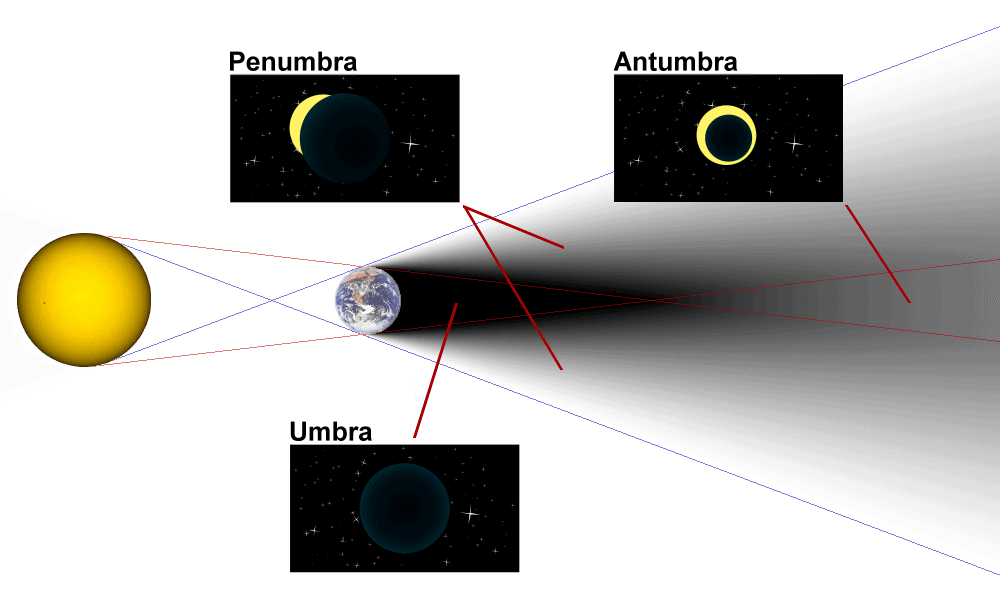
These shadows are responsible for both the lunar and solar eclipses, and each shadow causes a different type of eclipse to occur. However, how come there are three shadows?
Lunar Eclipse vs Solar Eclipse
When the Moon is between the Earth and the Sun, then a shadow is cast on the Earth by the Moon, resulting in a solar eclipse. If the Earth is between the Sun and the Moon, then Earth’s shadow reaches the Moon’s surface, causing a lunar eclipse.
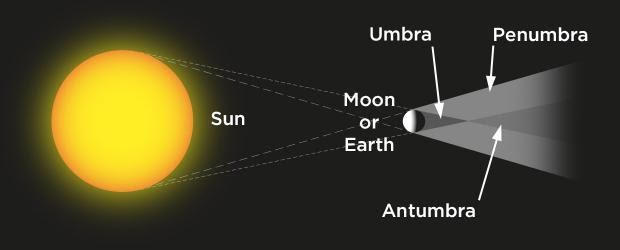
These are the two types of eclipses; however, both solar and lunar eclipses can be categorized into six types since both the Earth and the Moon cast three different shadows. Based on these shadows, we experience different types of eclipses. These three shadows are:
- Umbra
- Penumbra
- Antumbra
These three types of shadows create the six types of eclipses, such as total lunar eclipse, total solar eclipse, partial solar eclipse, partial lunar eclipse, penumbral lunar eclipse, and annular solar eclipse.
Now, let us see what umbra, penumbra, and antumbra are, and what kind of eclipses they can create.
Umbra
The umbra is the center portion of a shadow, being the darkest part. It is responsible for the greatest eclipses when it comes to astronomy. The umbra causes the total lunar eclipse, the total solar eclipse, and the partial lunar eclipse.
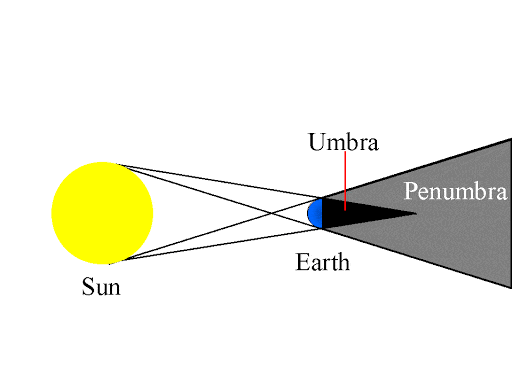
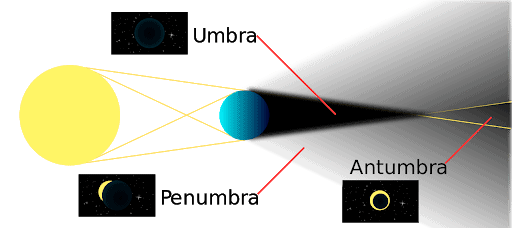
The total lunar eclipse occurs when the Earth’s umbra completely veils the Moon. In the case of a total solar eclipse, the Moon’s umbra falls on the Earth’s surface; however, only those within the umbra experience the eclipse. In the case of a partial lunar eclipse, the Earth’s umbra only partly covers the Moon.
Penumbra
The penumbra is the partially shaded outer region of the shadow cast by an opaque object. It is considered a half-shadow. The penumbra shadow is responsible for three different eclipses: the partial solar eclipse, the partial lunar eclipse, and the penumbral lunar eclipse.
The partial solar eclipse occurs when the Moon’s penumbra shadow covers a part of Earth, and only observers within it experience this event.
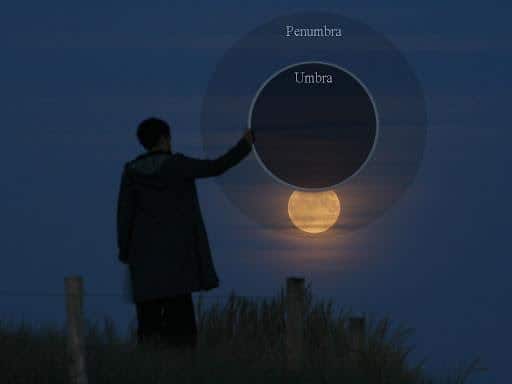
The partial lunar eclipse happens when the Earth’s penumbra veils a part of the Moon’s visible surface, which isn’t covered by the umbra.
The penumbral lunar eclipse is the event in which Earth’s penumbra covers all of the Moon or only a part of it, and the umbra of the shadow isn’t there.
The penumbral lunar eclipse is the most subtle out of all the three types of lunar eclipses. It is much more difficult to observe than a total lunar eclipse or a partial lunar eclipse.
Antumbra
The antumbra is the brighter part of a shadow that forms at a certain distance from the object casting the shadow. It is responsible for only one type of eclipse, the annular solar eclipse.
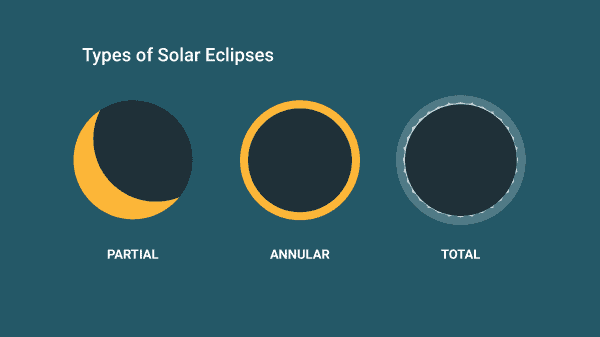
The annular solar eclipse occurs when the Moon’s antumbra falls on Earth’s surface, and the viewer is within the antumbra. Since Earth’s shadow extends far beyond the orbit of the Moon into space, the antumbra plays no role in lunar eclipses.
So, to sum it up, the umbra is the darkest and central part of a shadow, while the penumbra is the outer part, and the antumbra is the partly shaded area beyond the umbra.
Why Are There Three Shadows?
The light source and the opaque objects are responsible for the number and types of shadows created. The absolute size doesn’t matter so much.
For example, we can compare the Moon to a ball, and the Sun to a lamp and they would create the same types of shadows. Imagine this, there is a light source pointed at you, but there is an object as big as your head between it, and you’re head.
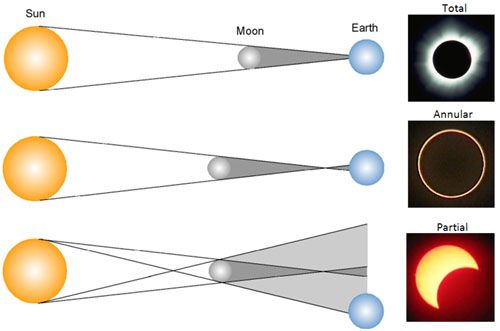
The object in front of you completely blocks the light source, and its shadow is cast uniformly, forming only an umbra. If the light source is bigger than the object in front of you, a second shadow will appear, the penumbra.
If the light source’s diameter is greater than that of the object, the third type of shadow will form where the V-shaped umbra ends, namely, the antumbra.
When is the Next Total Lunar Eclipse?
In 2021 we will experience a total lunar eclipse on May 26. It will be visible from South/East Asia, Australia, North America, South America, Pacific, Atlantic, Indian Ocean, and Antarctica.
The next total lunar eclipse will then happen on 15-16 May 2022. It will be visible in South/West Europe, South/West Asia, Africa, North America, South America, Pacific, Atlantic, Indian Ocean, and Antarctica.

The year 2022 will be quite spectacular since another total lunar eclipse will occur on November 8. It will be visible from North/East Europe, Asia, Australia, North & South America, Pacific, Atlantic, Indian Ocean, and Antarctica.
From 2022 things will settle down regarding total lunar eclipses; however, things will change in 2025. In 2025, we will experience two more total lunar eclipses. The first one will occur on 14-15 March, while the second one 7-8 September 2025. They will be visible through much of the globe.
Did you know?
- Total lunar eclipses can last for quite a long time, two hours, at least compared to total solar eclipses; this is long. The longest duration ever recorded concerning a total solar eclipse reached a record of 7.5 minutes.
- Eclipse shadows travel at great speed, at around 5,000 mph at the poles, and at about 1,100 mph at the equator. The width of the path of totality is at most 167 miles / 268 kilometers wide.
- In the worst case, only two eclipses are occurring each year on Earth. In the best case, only five eclipses can occur per year.
- Identical eclipses are quite rare, and they occur once every 18 years or so. This is known as the Saros cycle.
- We only notice a total solar eclipse when the Moon covers more than 90% of the Sun.
- Shadow bands are seen on the ground as totality approaches.
- During totality, temperatures can drop considerably, and animals might act weird.
- Eclipses don’t happen just on Earth; they can occur on any planet. Some planets with many moons, such as Jupiter, experience chaotic eclipses.
Sources:
Image Sources:
- https://upload.wikimedia.org/wikipedia/commons/2/2e/Diagram_of_umbra%2C_penumbra_%26_antumbra.png
- https://m.espacepourlavie.ca/sites/espacepourlavie.ca/files/styles/nocrop-gr8/public/ombre-penombre-antiombre_1240_an.jpg?itok=kI0FeIYi
- https://upload.wikimedia.org/wikipedia/commons/thumb/0/0d/Umbra01.svg/1280px-Umbra01.svg.png
- https://lh3.googleusercontent.com/proxy/NBVICFeSxIYibV-9kBu56byUFatejAtFghgoN4L1ICDWYWXy6lrQ10WStre6ElaD4rhvejgYGNfHxdzmi3xMdt1VvV6fGaFTEegQdEZ7BLnhtaxln1U
- https://c.tadst.com/gfx/600×337/types-of-solar-eclipses.png?1
- https://i.pinimg.com/originals/10/2d/f3/102df3fe27d922cdb5b8974610160b25.jpg
- https://img.jakpost.net/c/2018/05/25/2018_05_25_46576_1527239142._large.jpg
